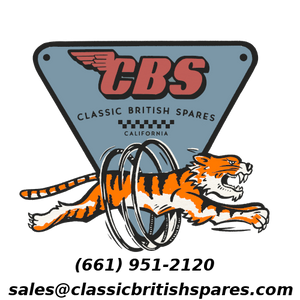The Anatomy Of The Lucas 6CA Points Assembly
Click on image to enlarge - download, print, share and save
From time to time we get customers and readers asking for a more detailed view and explanation of how the Lucas 6CA points assembly works.
Although points may seem like black magic to most folks there actually pretty simple to adjust, replace and install once you do it a few times.
Unfortunately today's blog post I will not be explaining how to adjust your points but instead provide you with this handy dandy anatomy sheet I designed and to also go over some facts and details regarding the 6CA points assembly.
Breakdown
The photo as shown above will aide you when you need to set your timing and adjust your points.
The first time I removed a points cover off of a Triumph twin I was terrorized by what I saw - it was horrific. A small cavity on the side of the engine containing electrical components that appeared only an engineer would understand.
That my friends was the 6CA points assembly.
Attempting to adjust the points I was unsure of which role a certain component played. I saw screws, adjusters, plates and a lot more confusing parts. However, I did get the points adjusted properly after hours of fiddling around and scratching my head.
Years later I finally got around to making this detailed diagram showing which each part actually means and its specific role in the points break down.
Using the detailed break down will aide a beginner and even a veteran. The best way to adjust points is understanding how everything works before attempting to adjust them.
Brief history
The Lucas 6CA points assembly was first introduced on vintage British motorcycles in 1968.
Reliability
If adjusted accordingly points can be just as reliable as any electronic ignition on the market whether it be a Boyer or Pazon EI.
The problem with points is that many folks are not capable or inclined to probably adjust them or set them.
Points may appear to be confusing but once you know how they work they are pretty much the same for vehicles and motorcycles alike.
If you're thinking of replacing your points to convert to an electronic ignition you always have to keep this in mind – if you're on the road and your electronic fails you will have to call a tow truck. If you have points fail you will be able to get back home (most cases).
Fact #1
All Lucas points plates have a manufacturing date and month stamped on the back.
For example 7 68 would indicate that the plate was manufactured in July, 1968.
The first single digit (7) would indicate the month and the second two digit number (68) would indicate the year.
Fact #2
The majority of the Lucas 6CA points assembly's we see today have wicks on the top and bottom on the plate to allow lubrication to the auto-advance unit lobes.
Early 6CA points plates didn't have wicks. If you take a look at the first photo in this blog post, you will see that the points plate does not have the wicks.
It later in the year when Lucas added the prongs to allow wicks (there may be an engine # change on this subject)
Fact #3
Lucas points plates are mostly interchangeable from the 4CA, 6CA and 10CA.
Engines fitted with the early 4CA units would be compatible if exchanged for the 6CA unit.
There is a lot of benefits when using the 6CA assembly on early models to replace the 4CA due to the fact that the 6CA is more adjustable and accurate.
"Always on the hunt..."
So there you have it - a little brief history on the 6CA points assembly.
At swap meets I'm always on the hunt for Lucas parts especially ignitions and for the 6CA points assembly's.
They are not difficult to find, typically when you find them they will be thrown in with a box with many other Lucas parts.
I hope you have found this blog informative and helpful. Please feel free to leave us a comment below. You can always share this link on Facebook or pin it on Pintrest.
Ride safe!



roy crabbe
Please where do you place the condensers when using 6CA?
Thankyou
Peter Charlton
I hyave three of these I wish to sell, good condition, but two have the part number 47632E on the back, the other 47650B, what are the differences, and what were their applications please?. I suspect one would have been from my Commando, and the others Triumph Unit 500 twins. In view of the opposite rotation of the auto-advance on these two bikes, did it make any differnce the way the points nylon heel met the AA cam?
Harry
Very good article about points. I will be swapping my 4CA for a 6CA on my 1963 T-120. Thanks for the great blog.
Jules Lemelle
Very useful and informative. Thanks!
Classic British Spares
@Relic Cycles – correct